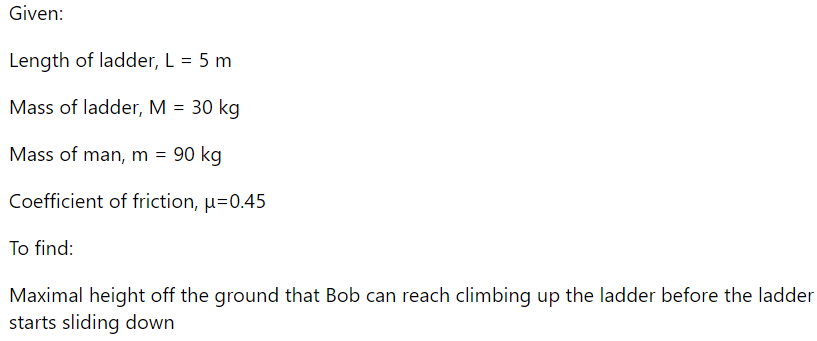A worker places an aluminum ladder on a horizontal concrete slab against a vertical wooden wall at 30 degrees from the vertical. The ladder has length L=5m and m=30 kg. The ladder’s CM is at a third of the length up. Worker Bob has mass M=90 kg and intends to climb up the ladder. Simultaneously, worker Charlie has mass M=90 kg and operates a rope through a single pulley to hoist a pail of mass m=30 kg. The axle of the pulley is anchored to the ladder at A=0.3 m along the ladder from the top point. Charlie is pulling the rope down with enough force to hoist the pail at uniform velocity. The mass of the pulley and rope are negligible. The friction in the pulley axle is negligible. The ladder is equipped with rubber booties and a rubber top. The kinetic friction coefficients are: rubber on dry concrete 0.9, rubber on dry wood 0.9, aluminum on wet concrete 0.2, aluminum on wet wood 0.2. Still disappointed with the ladder performance, Bob takes four old rubber boots, cuts off the tops and slides the improvised rubber galoshes over the four ends of the ladder. Assuming the same configuration as in part c but with rubber booties, what is his new safety limit (with the extra pail, under wet conditions)? The kinetic friction coefficient of rubber on wet concrete and rubber on wet wood is at least 0.45.
A worker places an aluminum ladder on a horizontal concrete slab against a vertical wooden wall at 30 degrees from the vertical. The ladder has length L=5m and m=30 kg. The ladder’s CM is at a third of the length up. Worker Bob has mass M=90 kg and intends to climb up the ladder. Simultaneously, worker Charlie has mass M=90 kg and operates a rope through a single pulley to hoist a pail of mass m=30 kg. The axle of the pulley is anchored to the ladder at A=0.3 m along the ladder from the top point. Charlie is pulling the rope down with enough force to hoist the pail at uniform velocity. The mass of the pulley and rope are negligible. The friction in the pulley axle is negligible. The ladder is equipped with rubber booties and a rubber top. The kinetic friction coefficients are: rubber on dry concrete 0.9, rubber on dry wood 0.9, aluminum on wet concrete 0.2, aluminum on wet wood 0.2. Still disappointed with the ladder performance, Bob takes four old rubber boots, cuts off the tops and slides the improvised rubber galoshes over the four ends of the ladder. Assuming the same configuration as in part c but with rubber booties, what is his new safety limit (with the extra pail, under wet conditions)? The kinetic friction coefficient of rubber on wet concrete and rubber on wet wood is at least 0.45.
Elements Of Electromagnetics
7th Edition
ISBN:9780190698614
Author:Sadiku, Matthew N. O.
Publisher:Sadiku, Matthew N. O.
ChapterMA: Math Assessment
Section: Chapter Questions
Problem 1.1MA
Related questions
Question
A worker places an aluminum ladder on a horizontal concrete slab against a vertical wooden wall at 30 degrees from the vertical. The ladder has length L=5m and m=30 kg. The ladder’s CM is at a third of the length up. Worker Bob has mass M=90 kg and intends to climb up the ladder. Simultaneously, worker Charlie has mass M=90 kg and operates a rope through a single pulley to hoist a pail of mass m=30 kg. The axle of the pulley is anchored to the ladder at A=0.3 m along the ladder from the top point. Charlie is pulling the rope down with enough force to hoist the pail at uniform velocity. The mass of the pulley and rope are negligible. The friction in the pulley axle is negligible. The ladder is equipped with rubber booties and a rubber top. The kinetic friction coefficients are: rubber on dry concrete 0.9, rubber on dry wood 0.9, aluminum on wet concrete 0.2, aluminum on wet wood 0.2.
Still disappointed with the ladder performance, Bob takes four old rubber boots, cuts off the tops and slides the improvised rubber galoshes over the four ends of the ladder. Assuming the same configuration as in part c but with rubber booties, what is his new safety limit (with the extra pail, under wet conditions)? The kinetic friction coefficient of rubber on wet concrete and rubber on wet wood is at least 0.45.

Transcribed Image Text:30°
Expert Solution
Step 1

Trending now
This is a popular solution!
Step by step
Solved in 4 steps with 4 images

Knowledge Booster
Learn more about
Need a deep-dive on the concept behind this application? Look no further. Learn more about this topic, mechanical-engineering and related others by exploring similar questions and additional content below.Recommended textbooks for you

Elements Of Electromagnetics
Mechanical Engineering
ISBN:
9780190698614
Author:
Sadiku, Matthew N. O.
Publisher:
Oxford University Press

Mechanics of Materials (10th Edition)
Mechanical Engineering
ISBN:
9780134319650
Author:
Russell C. Hibbeler
Publisher:
PEARSON

Thermodynamics: An Engineering Approach
Mechanical Engineering
ISBN:
9781259822674
Author:
Yunus A. Cengel Dr., Michael A. Boles
Publisher:
McGraw-Hill Education

Elements Of Electromagnetics
Mechanical Engineering
ISBN:
9780190698614
Author:
Sadiku, Matthew N. O.
Publisher:
Oxford University Press

Mechanics of Materials (10th Edition)
Mechanical Engineering
ISBN:
9780134319650
Author:
Russell C. Hibbeler
Publisher:
PEARSON

Thermodynamics: An Engineering Approach
Mechanical Engineering
ISBN:
9781259822674
Author:
Yunus A. Cengel Dr., Michael A. Boles
Publisher:
McGraw-Hill Education

Control Systems Engineering
Mechanical Engineering
ISBN:
9781118170519
Author:
Norman S. Nise
Publisher:
WILEY

Mechanics of Materials (MindTap Course List)
Mechanical Engineering
ISBN:
9781337093347
Author:
Barry J. Goodno, James M. Gere
Publisher:
Cengage Learning

Engineering Mechanics: Statics
Mechanical Engineering
ISBN:
9781118807330
Author:
James L. Meriam, L. G. Kraige, J. N. Bolton
Publisher:
WILEY